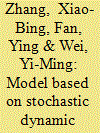| Srl | Item |
| 1 |
ID:
092605


|
|
|
|
|
| Publication |
2009.
|
| Summary/Abstract |
China's Strategic Petroleum Reserve (SPR) is currently being prepared. But how large the optimal stockpile size for China should be, what the best acquisition strategies are, how to release the reserve if a disruption occurs, and other related issues still need to be studied in detail. In this paper, we develop a stochastic dynamic programming model based on a total potential cost function of establishing SPRs to evaluate the optimal SPR policy for China. Using this model, empirical results are presented for the optimal size of China's SPR and the best acquisition and drawdown strategies for a few specific cases. The results show that with comprehensive consideration, the optimal SPR size for China is around 320 million barrels. This size is equivalent to about 90 days of net oil import amount in 2006 and should be reached in the year 2017, three years earlier than the national goal, which implies that the need for China to fill the SPR is probably more pressing; the best stockpile release action in a disruption is related to the disruption levels and expected continuation probabilities. The information provided by the results will be useful for decision makers.
|
|
|
|
|
|
|
|
|
|
|
|
|
|
|
|
| 2 |
ID:
162347


|
|
|
|
|
| Summary/Abstract |
Uncertainty in technological learning is a crucial factor in planning research, development, and demonstration (RD&D) strategies. Nevertheless, most previous work either models technological change as deterministic or accounts for uncertainty without fully capturing the recourse feature of the problem. This paper improves upon these approaches by developing a real options-based stochastic dynamic programming method for valuing and planning low-carbon energy RD&D investment and is the first of its kind to disaggregate the effects of R&D and learning-by-doing. This simplified model captures the relevant features of the problem and provides general insights on RD&D strategy under technological uncertainty. Results indicate that imminent deployment, high cost, lower exogenous cost reductions, and lower program funds all promote R&D spending over learning-by-doing, since under these circumstances a breakthrough, rather than slow and consistent cost reductions, will render the program successful.
|
|
|
|
|
|
|
|
|
|
|
|
|
|
|
|